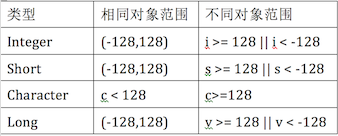一 定义
装箱:将基本类型转换成包装类对象
int i=10;
Integer x=new Integer(i);手动装箱
Integer y=10;自动装箱
拆箱:将包装类对象转换成基本类型的值
Integer j=new Integer(8);
int m=j.intValue();//手动拆箱
int n=j;//自动拆箱
实现:javac编译器的语法糖
二 原因
- 一个基本类型包装成一个类,可以使这个类型具有很多可以调用的方法
- 符合JAVA面向对象的编程思想
- 在泛型中,基本类型是不可以做泛型参数的。如:List <int> list = new ArrayList<int> ();这是不合法的。你只能这个样写List<Integer> list = new ArrayList<Integer> ();
三 详解
Integer total = 99;
执行上面那句代码的时候,系统为我们执行了:
Integer total = Integer.valueOf(99);
int totalprim = total;
执行上面那句代码的时候,系统为我们执行了:
int totalprim = total.intValue();
源码实现(以Integer类为例):
public static Integer valueOf(int i) {
//判断i是否在-128和127之间,存在则从IntegerCache中获取包装类的实例,否则new一个新实例
if (i >= IntegerCache.low && i <= IntegerCache.high)
return IntegerCache.cache[i + (-IntegerCache.low)];
return new Integer(i);
}
//使用亨元模式,来减少对象的创建(亨元设计模式大家有必要了解一下,我认为是最简单的设计模式,也许大家经常在项目中使用,不知道他的名字而已)
private static class IntegerCache {
static final int low = -128;
static final int high;
static final Integer cache[];
//静态方法,类加载的时候进行初始化cache[],静态变量存放在常量池中
static {
// high value may be configured by property
int h = 127;
String integerCacheHighPropValue =
sun.misc.VM.getSavedProperty("java.lang.Integer.IntegerCache.high");
if (integerCacheHighPropValue != null) {
try {
int i = parseInt(integerCacheHighPropValue);
i = Math.max(i, 127);
// Maximum array size is Integer.MAX_VALUE
h = Math.min(i, Integer.MAX_VALUE - (-low) -1);
} catch( NumberFormatException nfe) {
// If the property cannot be parsed into an int, ignore it.
}
}
high = h;
cache = new Integer[(high - low) + 1];
int j = low;
for(int k = 0; k < cache.length; k++)
cache[k] = new Integer(j++);
// range [-128, 127] must be interned (JLS7 5.1.7)
assert IntegerCache.high >= 127;
}
private IntegerCache() {}
}对于Integer total = 99; 系统为我们执行了Integer total = Integer.valueOf(99);
首先判断i值是否在-128和127之间,如果在-128和127之间则直接从IntegerCache.cache缓存中获取指定数字的包装类;不存在则new出一个新的包装类。
IntegerCache内部实现了一个Integer的静态常量数组,在类加载的时候,执行static静态块进行初始化-128到127之间的Integer对象,存放到cache数组中。cache属于常量,存放在java的方法区中。
8种基本类型的自动装箱
//boolean原生类型自动装箱成Boolean
public static Boolean valueOf(boolean b) {
return (b ? TRUE : FALSE);
}
//byte原生类型自动装箱成Byte
public static Byte valueOf(byte b) {
final int offset = 128;
return ByteCache.cache[(int)b + offset];
}
//byte原生类型自动装箱成Byte
public static Short valueOf(short s) {
final int offset = 128;
int sAsInt = s;
if (sAsInt >= -128 && sAsInt <= 127) { // must cache
return ShortCache.cache[sAsInt + offset];
}
return new Short(s);
}
//char原生类型自动装箱成Character
public static Character valueOf(char c) {
if (c <= 127) { // must cache
return CharacterCache.cache[(int)c];
}
return new Character(c);
}
//int原生类型自动装箱成Integer
public static Integer valueOf(int i) {
if (i >= IntegerCache.low && i <= IntegerCache.high)
return IntegerCache.cache[i + (-IntegerCache.low)];
return new Integer(i);
}
//int原生类型自动装箱成Long
public static Long valueOf(long l) {
final int offset = 128;
if (l >= -128 && l <= 127) { // will cache
return LongCache.cache[(int)l + offset];
}
return new Long(l);
}
//double原生类型自动装箱成Double
public static Double valueOf(double d) {
return new Double(d);
}
//float原生类型自动装箱成Float
public static Float valueOf(float f) {
return new Float(f);
}只有double和float的自动装箱代码没有使用缓存,每次都是new 新的对象,其它的6种基本类型都使用了缓存策略。
使用缓存策略是因为,缓存的这些对象都是经常使用到的(如字符、-128至127之间的数字),防止每次自动装箱都创建一次对象的实例。
而double、float是浮点型的,没有特别的热的(经常使用到的)数据的,缓存效果没有其它几种类型使用效率高。
下面对Integer派别进行一个总结,如下图:
四 实践
1.
public class Main {
public static void main(String[] args) {
Integer i1 = 100;
Integer i2 = 100;
Integer i3 = 200;
Integer i4 = 200;
System.out.println(i1==i2);
System.out.println(i3==i4);
}
}
//结果为:true false
2.
public class Main {
public static void main(String[] args) {
Double i1 = 100.0;
Double i2 = 100.0;
Double i3 = 200.0;
Double i4 = 200.0;
System.out.println(i1==i2);
System.out.println(i3==i4);
}
}
//结果为:false false
3.
1 Integer num1 = 400; 2 int num2 = 400; 3 System.out.println(num1 == num2); //true 对num1进行拆箱操作。
4.
1 Integer num1 = 100; 2 int num2 = 100; 3 System.out.println(num1.equals(num2)); //true
1 @Override
2 public boolean equals(Object o) {
3 return (o instanceof Integer) && (((Integer) o).value == value);
4 }
DEGUG一下

执行了装箱操作。
5.
1 Integer num1 = 100; 2 int num2 = 100; 3 Long num3 = 200l; 4 System.out.println(num1 + num2); //200 5 System.out.println(num3 == (num1 + num2)); //true 6 System.out.println(num3.equals(num1 + num2)); //false
1、当一个基础数据类型与封装类进行==、+、-、*、/运算时,会将封装类进行拆箱,对基础数据类型进行运算。
2、对于num3.equals(num1 + num2)为false的原因很简单,我们还是根据代码实现来说明:
1 @Override
2 public boolean equals(Object o) {
3 return (o instanceof Long) && (((Long) o).value == value);
4 }
它必须满足两个条件才为true:
1、类型相同
2、内容相同
上面返回false的原因就是类型不同。
6.
1 Integer num1 = 100; 2 Ingeger num2 = 200; 3 Long num3 = 300l; 4 System.out.println(num3 == (num1 + num2)); //true
1 int num1 = 100; 2 int num2 = 200; 3 long mum3 = 300; 4 System.out.println(num3 == (num1 + num2)); //true
所以,当 “==”运算符的两个操作数都是 包装器类型的引用,则是比较指向的是否是同一个对象,而如果其中有一个操作数是表达式(即包含算术运算)则比较的是数值(即会触发自动拆箱的过程)。
陷阱1:
1 Integer integer100=null; 2 int int100=integer100;
这两行代码是完全合法的,完全能够通过编译的,但是在运行时,就会抛出空指针异常。其中,integer100为Integer类型的对象,它当然 可以指向null。但在第二行时,就会对integer100进行拆箱,也就是对一个null对象执行intValue()方法,当然会抛出空指针异常。 所以,有拆箱操作时一定要特别注意封装类对象是否为null。
陷阱2:
Integer num1 = 100; Integer num2 = 100; System.out.println(num1==num2);
对于在-128至127之间的赋值,Integer对象是在缓存中产生的,会复用已有对象,可以用“==”,而范围之外,是在堆上产生新的对象,必须用equals。
总结:
1、需要知道什么时候会引发装箱和拆箱
2、装箱操作会创建对象,频繁的装箱操作会消耗许多内存,影响性能,所以可以避免装箱的时候应该尽量避免。
3、equals(Object o) 因为原equals方法中的参数类型是封装类型,所传入的参数类型(a)是原始数据类型,所以会自动对其装箱,反之,会对其进行拆箱
4、当两种不同类型用==比较时,包装器类的需要拆箱。同种包装类型比较用equals,
转载:























 2286
2286

 被折叠的 条评论
为什么被折叠?
被折叠的 条评论
为什么被折叠?








